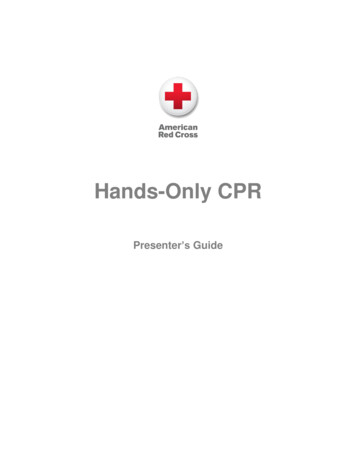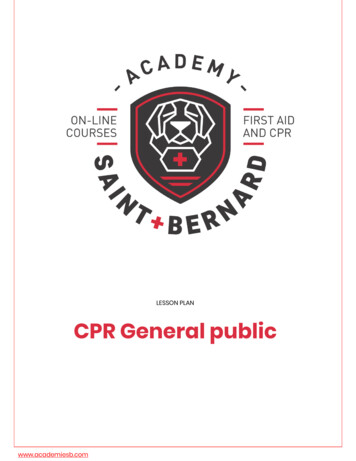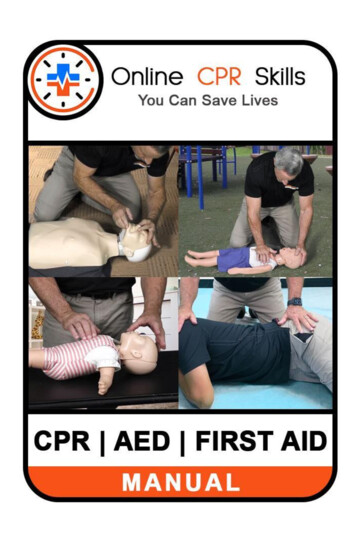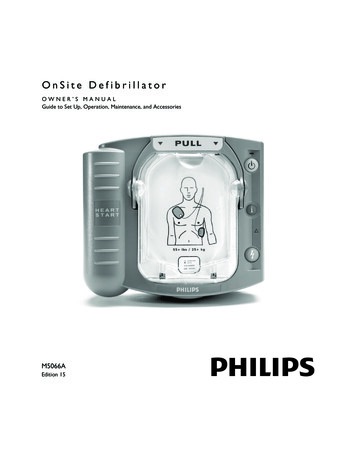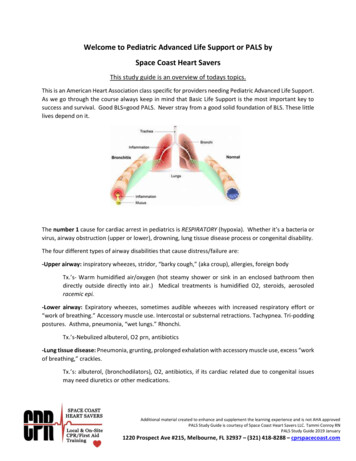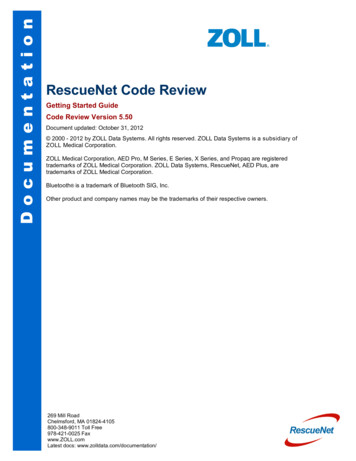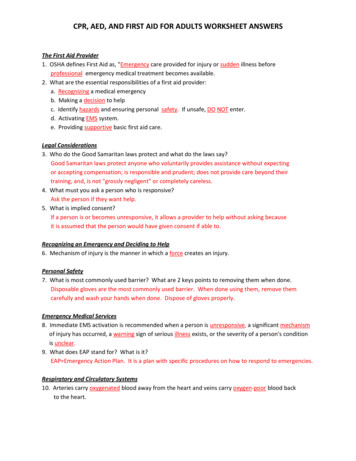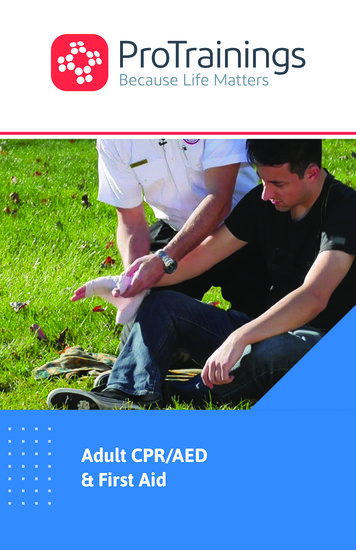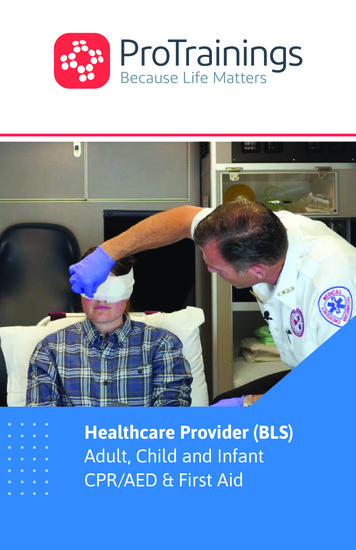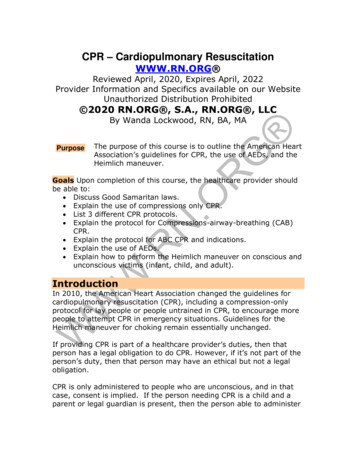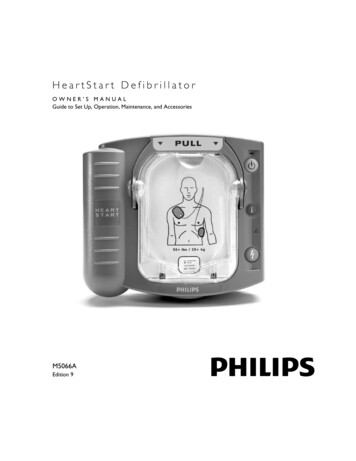
Transcription
HeartStart DefibrillatorOWNER’S MANUALGuide to Set Up, Operation, Maintenance, and AccessoriesM5066AEdition 9
Intentionally blank.P H I L I P S M E D I C AL S Y S TE M S
AtoptopBfront viewback viewPHILIPS MEDICAL SYSTEMSThe HeartStart Defibrillator M5066AAPads Cartridge Handle.Pull the handle to turn on theHeartStart and remove thecartridge’s hard cover.BReady Light. This green lighttells you the readiness of theHeartStart.Blinking:Solid:Off:Cstandby mode(ready for use)in useneeds attention(HeartStart“chirps” andi-button flashes)On/Off Button. Press thisgreen buttonto turn on theHeartStart. To turn off theHeartStart, press the greenbutton again and hold it down forone (1) second.D Information Button. Thisblue “i-button”flashes whenit has information you can accessby pressing it. It also flashes at thebeginning of a patient care pausewhen CPR coaching is enabled.EI Beeper. The HeartStart“chirps” through this beeper toalert you when it needs attention.Caution Light. Thistriangular lightflashes duringrhythm analysis and is on when ashock is advised, as a reminderthat no one should be touchingthe patient.FH Speaker. When the device isbeing used, its voice instructionscome from this speaker.Shock Button. Wheninstructed by the HeartStart todeliver a shock, press this flashingorange button.Infrared (IR)Communications Port. ThisGspecial lens, or “eye,” is used totransfer HeartStart data directlyto or from a computer.JSMART Pads Cartridge.This disposable cartridge containsself-adhesive pads with attachedcable. Shown with adult padscartridge.SMART Pads CartridgeLatch. Slide the latch to the rightKto release the pads cartridge forreplacement.LBattery. The non-rechargeable battery is inserted ina recess on the back of theHeartStart.
Intentionally blank.P H I L I P S M E D I C AL S Y S TE M S
HeartStart Defibrillator M5066AQUICK REFERENCEP H I L I P S M E D I C AL S Y S TE M SCheck for signs of Sudden Cardiac Arrest: 9 Unresponsive9 Not Breathing NormallyQUICK REFERENCE GUIDE
Intentionally blank.P H IL I P S M ED I C A L S YS TE M S
HeartStartM5066AAutomated External DefibrillatorOWNER’S MANUALEdition 9IMPORTANT NOTE:P H I L I P S M E D I C A L S Y S TE M SIt is important to understand that survival rates for sudden cardiac arrestare directly related to how soon victims receive treatment. For everyminute of delay, the chance of survival declines by 7% to 10%.Treatment cannot assure survival. In some victims, the underlying problemcausing the cardiac arrest is simply not survivable despite any available care.
Intentionally blank.P H IL I P S M ED I C A L S YS TE M S
About this editionAuthorized EU representativeThe information in this guide applies to themodel M5066A HeartStart Defibrillator.Its technical contents apply to all modelsin the HeartStart HS1 family of defibrillators,including the HeartStart, the HeartStart OnSite,and the HeartStart First Aid Defibrillator. Thisinformation is subject to change. Pleasecontact Philips at www.philips.com/productdocsor your local Philips representative forinformation on revisions.Philips Medizin Systeme Boeblingen GmbHHewlett-Packard Strasse 271034 Boeblingen, Germany( 49) 7031 463-2254Edition historyP H I L I P S M E D I C AL S Y S TE M SEdition 9Publication date: October 2010Publication #: 011872-0009CopyrightCAUTIONThe Philips HeartStart Defibrillator is designed to beused only with Philips-approved accessories. TheHeartStart may perform improperly if non-approvedaccessories are used.Device trackingIn the U.S.A., this device is subject to trackingrequirements by the manufacturer and distributors. Ifthe defibrillator has been sold, donated, lost, stolen,exported, or destroyed, notify Philips Medical Systemsor your distributor. 2010 Philips Electronics North America Corp.No part of this publication may be reproduced,transmitted, transcribed, stored in a retrievalsystem or translated into any human orcomputer language in any form by any meanswithout the consent of the copyright holder.Unauthorized copying of this publication maynot only infringe copyright but also reduce theability of Philips Medical Systems to provideaccurate and up-to-date information to usersand operators alike.Device manufacturerPhilips Medical Systems, Seattle, WA 98121-1825, USAPatentsThis product is manufactured and sold under one ormore of the following United States patents:US6047212, US6317635, US5891046, US5891049,US6356785, US5650750, US6553257, US5902249,US6287328, US6662056, US5617853, US5951598,US6272385, US6234816, US6346014, US6230054,US6299574, US5607454, US5803927, US5735879,US5749905, US5601612, US6441582, US5889388,US5773961, US6016059, US6075369, US5904707,US5868792, US5899926, US5879374, US5632280,US5800460, US6185458, US5611815, US6556864,US5607454, and other patents pending.
Intentionally blank.P H IL I P S M ED I C A L S YS TE M S
CONTENTS1 INTRODUCTION TO THE HEARTSTARTDescription .Sudden cardiac arrest .Indications for use .Implementation considerations .For more information .21-11-11-11-21-2SETTING UP THE HEARTSTARTP H I L I P S M ED I C A L S YS T E M SPackage contents . 2-1Setting up the HeartStart . 2-1Recommended accessories . 2-43USING THE HEARTSTARTOverview .STEP 1: PULL the green handle .STEP 2: PLACE the pads .STEP 3: PRESS the Shock button .Treating infants and children .When emergency medical services arrive .43-13-23-33-43-53-6AFTER USING THE HEARTSTARTAfter each use . 4-1HeartStart data storage . 4-35 MAINTAINING THE HEARTSTARTRoutine maintenance .Periodic checks .Cleaning the HeartStart .Disposing of the HeartStart .Troubleshooting tips .5-15-15-25-25-2i
APPENDICESA Accessories for the HeartStartB Glossary of termsC Glossary of symbols/controlsD Warnings and precautionsETechnical informationFConfigurationH Additional technical information required for European conformityiiP HI L I P S M E D I C A L S Y S T E M SG Testing and troubleshooting
11INTRODUCTION TO THE HEARTSTARTDESCRIPTIONThe HeartStart Defibrillator M5066A (“HeartStart”) is part of the PhilipsHeartStart HS1 family of automated external defibrillators (AEDs). Small,lightweight, and battery powered, the HeartStart is designed for simple andreliable operation.P H I L I P S M E DI C AL S Y S TE M SSUDDEN CARDIAC ARRESTThe HeartStart is used to treat the most common causes of sudden cardiacarrest (SCA), including ventricular fibrillation (VF). SCA is a condition thatoccurs when the heart unexpectedly stops pumping. SCA can occur to anyone –infant, child, adult, male or female – anywhere, at any time. Many victims of SCAdo not have warning signs or symptoms.VF is a chaotic quivering of the heart muscle that prevents it from pumpingblood. The only effective treatment for VF is defibrillation. The HeartStart treatsVF by sending a shock across the heart, so it can start beating regularly again.Unless this is successful within the first few minutes after the heart stopsbeating, the victim is not likely to survive.INDICATIONS FOR USEThe HeartStart should be used to treat someone you think may be a victim ofSCA. A person in SCA: does not respond when shaken, and is not breathing normally.If in doubt, apply the pads. Follow the voice instructions for each step in usingthe defibrillator.1-1
IMPLEMENTATION CONSIDERATIONSCheck with your local health department to see if there are any national or localrequirements about owning and using a defibrillator. The HeartStart AED is onepart of a well-designed emergency response plan. Recognized resuscitationcouncils recommend that emergency response plans include physician oversightand training in cardiopulmonary resuscitation (CPR).Several national and local organizations offer combined CPR/AED training.Philips recommends that you train on the device you will be using. Contact yourPhilips representative for information, or visit us online at www.philips.com/AEDservices to learn about certified training and web-based refresher training(offered in select areas) available through Philips AED Services.NOTE: Training accessories are available for practicing use of the AED. SeeAppendix A for information.Contact your local Philips representative for additional information about theHeartStart. We will be happy to answer any questions you may have and toprovide you with copies of the clinical summaries of several key studies usingPhilips automated external defibrillators.*Technical information about all Philips HeartStart automated externaldefibrillators is also available online at www.philips.com/productdocs in theTechnical Reference Manuals for HeartStart Automated External Defibrillators.* Clinical summaries also include Heartstream ForeRunner and FR2 Defibrillators.1-2P H I L I P S M E D I C AL S Y S TE M SFOR MORE INFORMATION
2SETTING UP THE HEARTSTART2PACKAGE CONTENTSP H I L I P S M E DI C AL S Y S TE M SCheck the contents of the HeartStart Defibrillator M5066A box to be sure itcontains: 1 HeartStart Defibrillator 1 battery M5070A, pre-installed 1 Adult SMART Pads Cartridge M5071A, containing one set of adhesivedefibrillation pads, pre-installed 1 Quick Reference Guide 1 Owner’s Manual 1 HeartStart Quick Setup Guide 1 inspection log/maintenance booklet with plastic storage sleeve andmaintenance tags*If you have purchased the HeartStart Ready-Pack configuration, the HeartStartis installed in a carry case, which also contains a spare adult SMART PadsCartridge.Training materials and optional accessories for the HeartStart are also availablefrom Philips. See Appendix A for a description of these items.SETTING UP THE HEARTSTARTSetting up the HeartStart is simple and quick. The HeartStart Quick SetupGuide provides illustrated instructions for setup, which is described in detailbelow.1.Remove the HeartStart from its packaging. Check that the battery and padscartridge are installed.†* In Japan, the defibrillator comes with a different style of maintenance tag and nspectionlog/maintenance booklet.† If the battery and pads are not installed, or if you wish to install an infant/child SMARTPads Cartridge, follow the directions in Chapter 4, “After Using the HeartStart” toinstall the pads and battery.2-1
NOTE: To prevent the pads’ adhesive gel from drying out, do not open thehard cover or film seal of the cartridge until you need to use the pads.2.Pull out and discard the green Setup tab.3.The HeartStart will automatically run a self-test.Press the Shock button when instructed. Be sureto let the self-test run all the way to completion.When the self-test is over, the HeartStart willreport the result, and tell you to push the greenOn/Off button in case of an emergency. (Do notpush the green button unless this is an actualemergency.) Then the HeartStart will turn off andgo to standby mode.* The green Ready light willbe blinking to show the HeartStart is ready for use.Install the HeartStart in its carry case, if it is not pre-installed. Ensure thatthe Quick Reference Guide† is face up in the clear plastic window on theinside of the carry case. Philips recommends that you store a spare padscartridge and spare battery with your HeartStart. If you are using a standardcarry case, there is an area in the upper lid of the case, under the flap, tostore a spare adult SMART Pads Cartridge or an infant/child SMART PadsCartridge and a spare battery.‡NOTE: Do not store anything in the defibrillator carry case that it is notdesigned to accommodate. Store all objects in their intended location in thecase.* As long as a battery is installed, turning the HeartStart “off” puts it into standby mode,which means that it is ready for use.† The illustration on the cover of the Quick Reference Guide is a 3-step guide to usingthe HeartStart. Detailed illustrated directions are inside, for reference in anemergency, or if you are hearing impaired or using the HeartStart where it is hard tohear the voice instructions.‡ See Chapter 4, “After Using the HeartStart,” for directions on how to replace thebattery in the HeartStart.2-2P H I L I P S M E D I C AL S Y S TE M S4.upSet
5.6.Use the maintenancetag* provided to recordthe expiration date ofthe installed padscartridge. If you have aspare pads cartridgeand spare battery,record the padsexpiration date andbattery install-by dateon the maintenance tag.EXP. 09/2010DATE2INSTL. DATEEXP. 09/2010DATEDEXP. 09/2010DATEINSTALLBEFORE08-2011INSTALLBEFOREEXP. DATE08-2011EXP. DATEEXPIRATIONDATE12/2010EXPIRATIONEXPIRATION DATE12/2010DATEEXPIRATIONDATE12/201012/2010The maintenance tag1and inspection log/maintenance bookletshould be kept with2your HeartStart.Adhere the plasticstorage sleeve* for thebooklet to the AED wallmount or cabinet andstore the booklet in it for ready reference.InspectionLog / MaintenanceVérifierla malletteTipsde Comprobarmaleta deControllaretransportela valigettaኊዀ ዙዘ ዙኖትኞኄአኌሼቮINSTL. DATEEXP. DATEP H I L I P S M E DI C AL S Y S TE M SEXP. DATE7.1. DATEINSTLncetenaport/ MaintransLog dectiontteTipsmalle rüfen porteInspeer la e überptastransቮVérifitaschr draag a deኌሼTragerolee r malet tta ኄአContproba la valigeትኞeCom rollar ዙኖዘ Cont ዙDATEEXP.DATEEXP.ኊዀ2Store the HeartStart in its carry case in accordance with your site’semergency response protocol. Typically, this will be in a high-traffic area thatis easy to access, convenient for checking the Ready light periodically, andeasy to hear the alarm chirp if the battery power gets low or the HeartStartneeds attention. Ideally, the location will be near a telephone, so theEmergency Response Team or Emergency Medical Services can be alertedas fast as possible in the event of a possible SCA.In general, treat the HeartStart as you would any piece of electronic equipment,such as a computer. Be sure to store the HeartStart according to itsspecifications. See Appendix E for details. As long as a battery and a padscartridge are installed, the green Ready light should be blinking to show that theHeartStart has passed its most recent self-test and is therefore ready to use.* In Japan, the defibrillator comes with a different style of maintenance tag andinspection log/maintenance booklet. Refer to the accompanying instructions for usingthese items.2-3
NOTE: Always store the HeartStart with a pads cartridge and a batteryinstalled, so it will be ready to use and can perform daily self-tests. Trainingpads should be stored separately from the HeartStart to avoid confusionduring a use.RECOMMENDED ACCESSORIESIt is always a good idea to have a spare battery and a spare pads set. Otherthings that are useful to keep with the HeartStart include:scissors — for cutting the victim’s clothes if needed disposable gloves — to protect the user a disposable razor — to shave the chest if hair prevents good padscontact a pocket mask or face shield — to protect the user a towel or absorbent wipes — to dry the victim's skin for good padscontactPhilips has a Fast Response Kit with all these items. See Appendix A forinformation.If you may need to defibrillate an infant or a child under 25 kg (55 pounds) or 8years old, it is recommended that you order the infant/child SMART PadsCartridge, available separately. When the infant/child SMART Pads Cartridge isinstalled in the HeartStart, the HeartStart automatically reduces thedefibrillation energy to an energy level more appropriate for infants and children.In addition, if optional CPR Coaching is selected, the HeartStart providescoaching appropriate for infants and children. Directions for using the infant/child SMART Pads Cartridge are provided in Chapter 3, “Using the HeartStart.”2-4P H I L I P S M E D I C AL S Y S TE M S
3USING THE HEARTSTARTIMPORTANT NOTE: Be sure to read the Reminders section at the end of thischapter as well as the warnings and precautions in Appendix D.OVERVIEWP H I L I P S M E DI C AL S Y S TE M SIf you think someone is in SCA, act quickly and calmly. If someone else is available,ask him or her to call for emergency medical assistance while you get theHeartStart. If you are alone, follow these steps: Call your emergency services provider. Quickly get the HeartStart and bring it to the victim’s side. If there isany delay in getting the defibrillator, check the patient and performcardiopulmonary resuscitation (CPR) if needed until the HeartStart isavailable. If the patient is an infant or child, first perform CPR, then call foremergency medical services (EMS) before you apply the HeartStart.See special section on treating infants and children on page 3-5. Check the immediate environment for flammable gases. Do not use theHeartStart in the presence of flammable gases, such as an oxygen tent.However, it is safe to use the HeartStart on someone wearing anoxygen mask.There are three basic steps to using the defibrillator to treat someone who maybe in sudden cardiac arrest:1.2.3.PULL up the handle on the SMART Pads Cartridge.PLACE the pads on the patient’s bare skin.PRESS the flashing Shock buttonif instructed.The following pages provide details about each step.3-13
STEP 1: PULL THE GREEN HANDLETurn on the HeartStart by pulling the SMART Pads Cartridge’s green handle.*Remove the hard cover from the pads cartridge and set it aside. Remain calmand follow the HeartStart’s instructions.55 lbs/25 kg* You can also turn on the HeartStart by pressing the green On/Off button.3-2P H I L I P S M E D I C AL S Y S TE M SThe HeartStart starts by directing you to remove all clothes from the patient’schest. If necessary, rip or cut off the clothing to bare the person’s chest
STEP 2: PLACE THE PADSPull the tab at the top of the pads cartridge to peel off the film seal. Inside aretwo adhesive pads on a plastic liner. Remove the pads from the cartridge.3P H I L I P S M E DI C AL S Y S TE M SPeel one pad off the liner. Place the pad on the patient’s bare skin, exactly asshown in the picture on the pad. Press the pad down firmly. Then repeat this withthe other pad. Be sure the pads have been removed from the liner before placingthem.Where to place pads on adults and children over25 kg/55 pounds or 8 years old (anterior-anterior).Where to place pads on infants or children under25 kg/55 pounds or 8 years old (anterior-posterior).3-3
STEP 3: PRESS THE SHOCK BUTTONAs soon as the HeartStart detects that the pads are attached to the patient, itbegins analyzing the patient’s heart rhythm. It tells you that no one should betouching the patient, and the Caution lightbegins flashing as a reminder.If a shock is needed:The Caution lightgoes from flashing to solid, the orange Shock buttonstarts flashing, and the defibrillator tells you to press the flashing orange button.Before you press the button, make sure no one is touching the patient. Whenyou press the Shock button, the defibrillator tells you that the shock has beendelivered. Then the HeartStart tells you it is safe to touch the patient, instructsyou to begin CPR, and invites you to press the flashing blue i-buttonfor CPRCoaching if desired.For CPR Coaching:during the first 30 seconds of the patientPress the flashing blue i-buttoncare pause to activate CPR Coaching.* (If the Infant/Child SMART PadsCartridge is inserted, CPR Coaching will provide coaching for infant/child CPR.)When the pause is over, the defibrillator tells you to stop CPR, so it can analyzethe patient’s heart rhythm. The motion caused by CPR can interfere withanalysis, so be sure to stop all motion when instructed.* The default configuration for the HeartStart provides CPR Coaching when you pressthe i-button in this situation; however, the default setting can be revised by yourMedical Director using Philips software available separately. See Appendix F for moreinformation.3-4P H I L I P S M E D I C AL S Y S TE M SIf a shock is not needed:The HeartStart tells you it is safe to touch the patient and instructs you toperform CPR if needed. (If CPR is not needed – for example, if the patient ismoving or regaining consciousness – follow your local protocol until emergencymedical personnel arrive.) Then the HeartStart invites you to press the flashingblue i-buttonfor CPR Coaching, if desired.
TREATING INFANTS AND CHILDRENWARNING: Most cardiac arrests in children are not caused by heartproblems. When responding to cardiac arrest in an infant or child: Provide infant/child CPR while a bystander calls EMS and brings theHeartStart. If no bystander is available, provide 1-2 minutes of CPR before calling EMSand retrieving the HeartStart. If you witnessed the child's collapse, call EMS immediately and then get theHeartStart.Alternatively, follow your local protocol.P H I L I P S M E DI C AL S Y S TE M SIf the patient is under 55 pounds or 8 years old, and you have an infant/child SMARTPads Cartridge: Remove the infant/child SMART Pads Cartridge from its package.* Locate the latch at the top edge of the defibrillator, and slide it to theside. The pads cartridge will be released. Remove the old cartridge. Install the new cartridge: slide the bottom end of the cartridge into therecess, then press in the cartridge until the latch clicks into place. Besure the green handle is pressed down firmly. The HeartStart will tellyou that infant/child pads have been inserted, then it will turn off to beready for use. Pull the green handle to start the rescue. Remove all clothing from the upper body, to bare both the chest andthe back. Place one pad in the center of the chest between the nipples,and the other in the center of the back (anterior-posterior).With the infant/child SMART Pads Cartridge inserted, the HeartStartautomatically reduces the defibrillation energy from the adult dose of 150 joulesto 50 Joules† and provides optional infant/child CPR Coaching. Place the padsexactly as shown on the illustration on the pads.* Philips recommends that the HeartStart be stored with an adult pads cartridgeinstalled, as pediatric cardiac arrest is not common.† This lower energy level may not be effective for treating an adult.3-53
If the patient is under 55 pounds or 8 years old, but you do NOT have an Infant/ChildSMART Pads Cartridge: DO NOT DELAY TREATMENT. Remove all clothing from the torso, to bare both the chest and theback. Apply the HeartStart using the adult pads cartridge, but place one padin the center of the chest between the nipples, and the other in thecenter of the back (anterior-posterior).If the patient is over 55 pounds or 8 years old, or if you are not sure of the exactweight or age:DO NOT DELAY TREATMENT. Remove all clothing from the chest. Apply the HeartStart using the adult pads cartridge, and place the padsas illustrated on the pads (anterior-anterior). Make sure the pads donot overlap or touch each other.WHEN EMERGENCY MEDICAL SERVICES ARRIVEWhen Emergency Medical Services (EMS) personnel arrive to care for thepatient, they may decide to apply another defibrillator to allow monitoring of thepatient. The SMART Pads should be removed from the patient prior to usinganother defibrillator. EMS personnel may want a summary of the last-use data*stored in the HeartStart. To hear the summary data, hold down the i-buttonuntil the HeartStart beeps.NOTE: After the EMS team removes the SMART Pads from the patient,remove the used pads cartridge, and insert a new pads cartridge beforereturning the HeartStart to service, to be sure it is ready for use.* See Chapter 4, “After using the HeartStart” for details about data storage.3-6P H I L I P S M E D I C AL S Y S TE M S
REMINDERS Remove any medicine patches and residual adhesive from the patient’s chestbefore applying the pads. Do not allow the pads to contact other electrodes or metal parts that arein contact with the patient. Avoid placing the pads directly over an implanted pacemaker or defibrillator.A noticeable lump with a surgical scar should indicate the position of animplanted device.P H I L I P S M E DI C AL S Y S TE M S If the pads do not stick well, check that the pads adhesive has not dried out.Each pad has a layer of adhesive gel. If the gel is not sticky to the touch,replace the pads with a new set. Keep the patient still and keep any movement around the patient to aminimum during rhythm analysis. Do not touch the patient or the padswhile the Caution light is on solid or flashing. If the HeartStart is unable toanalyze due to electrical “noise” (artifact), it will tell you to stop allmovement and remind you not to touch the patient. If the artifact continuesfor more than 30 seconds, the HeartStart will pause briefly to allow you todeal with the source of the noise, then resume analysis. The HeartStart will not deliver a shock unless you press the flashing orangeShock button. If you do not press the Shock button within 30 seconds afterthe defibrillator tells you to, it will disarm itself, and (for the first CPRinterval) give a reminder to make sure emergency medical services havebeen called, then begin a CPR interval. This is designed to minimizeinterruption of CPR and help ensure ongoing patient support. While waiting for you to press the Shock button, the HeartStart willcontinue to analyze the heart rhythm. If the patient’s rhythm changes beforeyou press the Shock button, and a shock is no longer needed, thedefibrillator will disarm and tell you a shock is not advised. If for any reason you want to turn off the defibrillator during a use, you canpress the On/Off button – holding it down for at least one second – toreturn the device to standby mode.3-73
NOTESP H I L I P S M E D I C AL S Y S TE M S
4AFTER USING THE HEARTSTARTP H I L I P S M E DI C AL S Y S TE M SAFTER EACH USE1.Check the outside of the HeartStart for signs of damage, dirt, orcontamination. If you see signs of damage, contact Philips for technicalsupport. If the HeartStart is dirty or contaminated, clean it according to theguidelines in Chapter 5, “Maintaining the HeartStart.”2.The single-use pads must be replaced after beingused. Locate the latch at the top edge of theHeartStart and slide it to the side. The padscartridge will be released. Lift out the used padscartridge.3.Remove a new SMART Pads Cartridge from itspackage and insert the cartridge into the cartridge well on the front of theHeartStart. It should click into place when properly seated. The green PULLhandle should be all the way down.55 lbs/25 4kg55 lbs/25 kgNOTE: To prevent the pads’ adhesive gel from drying out, do not open thehard cover or film seal of the cartridge until you need to use the pads.4.Check supplies and accessories for damage and expiration dates. Replaceany used, damaged or expired items. Use a new maintenance tag to recordthe pads expiration date for the new installed pads cartridge. If you replacethe spare pads and/or battery be sure to record the dates for them on themaintenance tag as described in Chapter 2. Then sign and date theinspection log/maintenance booklet.4-1
5.Unless your protocol requires that the battery remain installed, remove thebattery for five seconds, then reinstall it to run the battery insertion selftest to check the operation of the HeartStart.* When the test is complete,check that the green Ready light is blinking.topbackBattery installation.6.NOTE: Always store the HeartStart with a pads cartridge and a batteryinstalled, so it will be ready to use and can perform daily self-tests.7.Return the HeartStart to its storage location so it will be ready for usewhen needed. Place the updated inspection log/maintenance booklet on thedefibrillator wall mount or cabinet.* If you leave the battery in the HeartStart after using the defibrillator, then transfer thelast-use data to a computer running HeartStart Event Review software, the softwarewill calculate the local date and time of the device use. However, if you remove thebattery prior to transferring the data, the software will only show elapsed time.† As long as a battery is installed, turning the HeartStart “off” puts it into standby mode,which means that it is ready for use.4-2P H I L I P S M E D I C AL S Y S TE M SThe HeartStart will automatically run a self-test when the battery isinserted. Press the Shock button when instructed. Be sure to let the selftest run all the way to completion. When the self-test is over, theHeartStart will report the result, and tell you to push the green On/Offbutton in case of an e
SUDDEN CARDIAC ARREST The HeartStart is used to treat the most common causes of sudden cardiac arrest (SCA), including ventricular fibrillation (VF). SCA is a condition that occurs when the heart unexpectedly stops pumping. SCA can occur to anyone – infant, child, adult, mal
